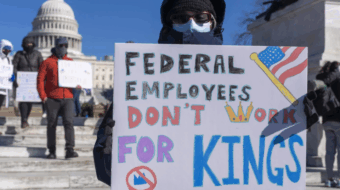
WASHINGTON—In the decades since the Occupational Safety and Health Administration (OSHA) was established, there’s been a lot of progress in cutting worker deaths and injuries on the job. However, there’s still a long way to go.
That’s a big conclusion from the data in the AFL-CIO’s 30th annual Death On The Job report, released May 4, a week after OSHA’s 50th anniversary.
The Occupational Safety and Health Act, strongly pushed by organized labor, has helped cut deaths on the job from nine per 100,000 workers 30 years ago to 3.5 per 100,000 in 2019. The report with the latest available data shows this.
The death rate has stalled at that level ever since the anti-worker anti-safety GOP Trump regime took over in 2017. And the 3.5/100,000 rate still translates into having 275 workers die every day from hazardous working conditions, the report says.
Those figures actually understate the case, AFL-CIO Secretary-Treasurer Liz Shuler told the Zoom press conference unveiling the report. “About 95,000 workers a year die from occupational illnesses,” often contracted long before, she pointed out. And illness and death disproportionately hit workers of color, she added.
The law’s weak penalties don’t help. The maximum federal fine for the death of a worker on the job is $12,788, though some states have higher fines. The maximum jail time if a worker dies is six months. And state and federal OSHAs combined have fewer inspectors now, 1,798, than 30 years ago. “The problems are structural,” Shuler said, adding corporate opposition has hamstrung new worker safety rules for years.
“But we have some good news: We have a pro-worker president, a pro-worker vice president, and a pro-worker majority in Congress,” which gives workers “a chance to improve the OSH Act and beef up enforcement,” Shuler said.
Left unsaid: The 50-50 Senate gives anti-worker anti-OSHA Republicans enough votes to filibuster the law labor is pushing, the Protect American Workers Act, to death.
Reiterates a hope
The report itself reiterates that hope. “The recent election of President Biden brings promise and hope to a nation and world decimated by the COVID-19 pandemic, and to working people who have struggled for years under anti-worker policies that make their workplaces more dangerous,” it says.
“But 50 years after the passage of the nation’s job safety laws, the toll of workplace injury, illness, and death remain too high, and too many workers remain at serious risk. There is much more work to be done.”
The opposition also hamstrung even collecting accurate and up-to-date job safety and health figures. Thus, both OSHA’s and the federation’s figures are a year or more behind. That means the agency understates the impact of the coronavirus pandemic.
So the fed took a shot at that impact. The report has a separate coronavirus section, even though the government does not require Covid-19 (coronavirus) illnesses and deaths to be reported by industry, AFL-CIO Safety and Health Director Rebecca Reindel pointed out. That’s another hole in enforcement, she said.
Trumpites ordered enforcement downplayed so much that tracing virus outbreaks, much less enforcing worker safety against Covid19, was difficult at best.
“We had a Covid-19 outbreak” at the AT&T call center in Nashville, Tenn., said Eric Chapman of Communications Workers 3808. “We tried to have the sales department work from home” to stop the community spread of the virus in the workplace. Such a spread is a common occurrence, workers on the Zoom conference call said.
“There were 300 people crowded together. Ten to 12 were infected. Being six feet apart did not seem to protect us,” he added. “Last October, everyone was scared for our lives. We were treated like we were disposable.” But AT&T did nothing until one died.
OSHA outbreaks were not counted by state, except for nursing homes, prisons and meatpackers, and allied occupations. And the AFL-CIO gathered those.
Nebraska led the nation in Covid-19 cases in meatpacking plants (7,236), followed by Iowa (6,609), Arkansas (6,600), and North Carolina (4,803). Nebraska (28), Kansas (27), North Carolina (23), and Iowa and Arkansas (22 each) led in deaths among packing plant workers.
National Nurses United co-President Zenei Cortez, RN, recounted how, even before the pandemic was officially declared on March 13, 2020, her union and its 190,000 registered nurses campaigned for personal protective equipment (PPE) for front-line workers.
They also agitated and sued for an OSHA temporary emergency standard ordering firms to create and implement anti-virus plans to protect workers and customers. The GOP Trump administration fought those demands and crowed about beating the AFL-CIO and NNU in the court case.
Sent a proposal
Democratic President Joe Biden’s OSHA sent a proposed standard to Biden’s Office of Management and Budget for review on April 26. NNU wants an OK by May 12. It’s needed. “Covid-19 is not over. It’ll remain a threat to workers for the foreseeable future,” said Shuler.
At the start of the pandemic, Cortez said her hospital “locked PPE up” and forced nurses to reuse N95 masks and respirators, which are designed to be disposable after one use. That endangered nurses and patients.
NNU conducted hundreds of protests, marches on hospitals and hospital magnates’ homes, plus solemn scenes of empty shoes, representing RNs killed by PPE and, though Cortez didn’t say so some forced strikes. NNU members got PPE and other protection. Non-union nurses didn’t or couldn’t, Cortez said.
One graphic in the report, of Covid19 infections among staffers in U.S. nursing homes, by week, showed 8,773 infections in the first week of data, ending last June 7. The count rose to a peak of 22,671 in the week ending Dec. 13, followed by 22,565 the next week and 21,751 in the week ending Dec. 23. The latest figure for the week ending April 11, 2021: 2,301. That was 650 more than the so-far all-time weekly low a month before.
Federal OSHA reported receiving 3,103 complaints about covid-19 in the health care industry last year, another chart shows. Retail trade (1,652) and restaurants (854) placed second and third. There were no complaint figures for state OSHAs, which cover more than half of the states. And the complaints led to little enforcement: 1,133 federal violation citations, 2.,421 state violation citations.
Other report details included:
- The most dangerous states for workers were Alaska (14.1 deaths/100,000 workers), Wyoming (12/100,000), North Dakota (9.7/100,000), Montana (7.8/100,000), and West Virginia (6.4/100,000).
- The most dangerous occupations were agriculture, forestry, and fishing and hunting (23.1 deaths per 100,000 workers), mining, quarrying, and oil and gas extraction (14.6/100,000), transportation, and warehousing (13.9/100,000 workers), construction (9.7/100,000), and wholesale trade (4.9/100,000).
- Agriculture and those related occupations annually lead all occupations in death rates, figures in prior AFL-CIO reports show. And this report notes that while death rates have fallen—in some cases drastically—in the other most dangerous job categories, they’ve barely budged in agriculture and related occupations. The death rate there 30 years ago was 24/100,000 workers.
- While the report did not say so, more so-called “right to work” states—including three of the five worst–had higher death rates for workers. The bottom five included Wyoming (49th from the top), North Dakota (48th), and West Virginia (46th). A GOP state legislative attempt to add Montana (47th) to the list was clobbered earlier this year as Republicans abandoned RTW.
Other RTW states and their rankings, with 50thbeing worst: Alabama and Oklahoma (tied for 30th), Arizona (11), Arkansas (40), Florida (18), Georgia (33), Idaho (27), Indiana, and Iowa (tied at 35), Kansas (43), Kentucky (30), Louisiana (44), Michigan private sector (22), Mississippi (41), Nebraska (42), Nevada (13), North Carolina (25), South Carolina (39), South Dakota and Texas (tied for 35th), Tennessee (25), Utah (20), Virginia (33) and Wisconsin (24).
- OSHA doesn’t cover the self-employed, meaning independent contractors, and their fatality rate—13.2 per 100,000—shows it. In 2019, 1,098 such workers died on the job, one-fifth of all deaths. By contrast, wage and salary workers had a 2.9/100,000 death rate. This year, these (contractor) data no longer were reported due to an update in disclosure methodology and reduction in publishable data—decreasing the transparency.










